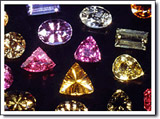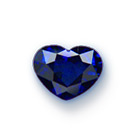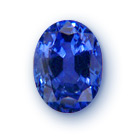SAPPHIRE
SEPTEMBER
BIRTHSTONE
 The sky is just a gigantic blue Sapphire stone into
which the earth is embedded – this belief was cherished in ancient times. And,
in fact, does there exist a better image to describe the beauty of an immaculate
Sapphire of purest blue? This gemstone exists in all the shades of blue skies,
from the deep blue of evening skies to the bright and deep blue of a clear and
beautiful summer sky which charms all people. The splendid gemstone, however,
also comes in many other colors, not only in the transparent grayish misty blue
of far horizons, but also displaying the bright fireworks of sunset colors –
yellow, pink, orange and purple. So Sapphires are really and truly heavenly
stones, although they are being found in the hard soil of our so-called "blue
planet”.
The sky is just a gigantic blue Sapphire stone into
which the earth is embedded – this belief was cherished in ancient times. And,
in fact, does there exist a better image to describe the beauty of an immaculate
Sapphire of purest blue? This gemstone exists in all the shades of blue skies,
from the deep blue of evening skies to the bright and deep blue of a clear and
beautiful summer sky which charms all people. The splendid gemstone, however,
also comes in many other colors, not only in the transparent grayish misty blue
of far horizons, but also displaying the bright fireworks of sunset colors –
yellow, pink, orange and purple. So Sapphires are really and truly heavenly
stones, although they are being found in the hard soil of our so-called "blue
planet”.
Blue is Sapphire’s main color. Blue is also the favorite color of about 50 per
cent of the population, men and women alike. This color, which is strongly
associated with sapphire, is also linked to emotions such as sympathy and
harmony, friendship and loyalty. These emotions belong to features which are
permanent and reliable – emotions where overwhelming and fiery passion is not
the main element, but rather composure, mutual understanding and unshakeable
trust. Sapphire blue has thus become a color related to anything permanent and
reliable, and this is one of the reasons why women in many countries settle on
Sapphire for their engagement rings. Sapphire symbolizes loyalty and
faithfulness, while at the same time expressing love and yearning. The most
famous musical example for this melancholic shade of blue can be found in George
Gershwin’s "Rhapsody in Blue". Sapphire’s blue color is also evoked where clear
competence and controlled brainwork are the issue. After all, the first computer
ever to wrangle a victory from a chess grandmaster and world champion was named
"Deep Blue".
...AND NOT
JUST BLUE
Its beauty, magnificent colors, its transparency but
also its resistance and permanence are characteristics which gemstone lovers and
experts assign to this gemstone – however, this does not only apply to blue
Sapphire as will be pointed out later on. Sapphire belongs to the corundum group
which is set apart from other gemstones by their very good hardness (Grade 9 on
the Mohs’ scale). They are second in hardness to diamonds only, and diamonds
represent the hardest mineral on Earth! Because of their good harness, sapphires
are easy to care for as gemstones and demand from their wearers only the usual
and normal care.
The corundum group consists of pure aluminum oxide, which a long time ago was
caused to crystallise into beautiful and splendid gemstones by the pressure and
heat in the depths of the ground. Small proportions of other elements, mainly
iron and chrome, are responsible for the resulting colors and make the basically
white crystals a blue, red, yellow, pink or greenish Sapphire. But this dies not
necessarily imply that any corundum is a sapphire. Which stone may be termed a
Sapphire – this is a question which for centuries has fuelled heated discussions
among experts. Finally agreement was achieved to call ruby-red Sapphires
"Rubies”, and all other colors "Sapphires".
 If we talk about Sapphires, most gemstone lovers will immediately think of a
velvety blue. It is an adaptable color which is attractive on many people. A
blue Sapphire is optimally suited to a well-balanced style of life, where
reliability is joined with spirit, and where there is an openness for new ideas
and influences – just like the woman wearing it. The fact that this beautiful
gemstone does also exist in many other colors was for a long time an piece of
information known to insiders only. In the gemstone trade any non-blue Sapphire
is termed "fancy”. And to clear up matters the color denominations are also
used, so that when talking about fancy
Sapphires, we talk about yellow, purple, pink, green or white Sapphire, etc.
Fancy sapphires are the epitome of individualism, the perfect choice for women
who love unique coloured gemstone jewelry. These Sapphires exist in a charming
variety of designs - set in rings, as pendants or earrings, as solitary stones,
in elegant line-ups or as sparkling pavé.
If we talk about Sapphires, most gemstone lovers will immediately think of a
velvety blue. It is an adaptable color which is attractive on many people. A
blue Sapphire is optimally suited to a well-balanced style of life, where
reliability is joined with spirit, and where there is an openness for new ideas
and influences – just like the woman wearing it. The fact that this beautiful
gemstone does also exist in many other colors was for a long time an piece of
information known to insiders only. In the gemstone trade any non-blue Sapphire
is termed "fancy”. And to clear up matters the color denominations are also
used, so that when talking about fancy
Sapphires, we talk about yellow, purple, pink, green or white Sapphire, etc.
Fancy sapphires are the epitome of individualism, the perfect choice for women
who love unique coloured gemstone jewelry. These Sapphires exist in a charming
variety of designs - set in rings, as pendants or earrings, as solitary stones,
in elegant line-ups or as sparkling pavé.
...AND NOT
JUST FACETED
But there are even more surprises about Sapphire: for example, there is an
orange color variety with a fine pinkish undertone, which has been given the
poetic name ”Padparadsha”, meaning "lotus flower”. Another rarity are the star
Sapphires. These are stone cut in half-dome shape displaying a star-shaped
light phenomenon, which seems to dance magically across the stone’s surface when
the Sapphire is moved. There exist rumors about gemstone lovers who have forever
and truly lost their hearts to these sapphire rarities – but then, permanence
and loyalty come along with these stones.
Sapphires, these gemstones of the skies, rest hidden
away in only few places of the earth and have to be brought to daylight in
laborious procedures. Sapphires are found in India, Burma, Ceylon, Thailand,
Vietnam, Australia, Brazil and Africa. From the gemstone mines the rough
crystals are supplied to the cutters, where skilled hands turn the into
sparkling gemstones. A cutter must draw on all his experience and deftness when
cutting sapphire, because these gemstones are not only hard, they also display a
different coloring and satiation depending on the perspective. Therefore, then,
the cutter must align the orientation of the stone in such a way as to bring
about the best possible display of color.
Depending on the place of occurrence the depth of color as well as the shade
displayed by the cut stones will vary, which in turn offers a wider range to
select from. So shall a woman who has decided on a sapphire go for the medium
blue stone evoking the summer skies even on a rainy day? Or should she rather
prefer a lighter blue, because it sparkles brilliantly also in the evening?
Bright daylight makes most Sapphires shine more vividly than the somewhat muted
artificial light. Therefore the most highly cherished color for blue sapphires
is not the darkest blue as is often claimed, but a deep and satiated blue, which
even in dim artificial light remains to appear blue.
For experts and connoisseurs the Kashmir-color with its velvety sheen is
considered the most beautiful and valuable shade. The wonderful Kashmir
gemstones, which were found in 1880 after an avalanche had come down in a height
of 5000 m, and which were intensively mined then for eight years, have for all
times set the standard for our ideas of the color of a top quality Sapphire.
Typical for the Kashmir color is a pure and intensive blue, which is enhanced by
a fine, silky gloss. It is reported that this color does not change in
artificial light. But Burma-color is also considered especially valuable. It
ranges from rich royal blue to deep cornflower blue.


The oldest Sapphire mines are situated in Ceylon, today called Sri Lanka, where
gemstones were mined in ancient times. The expert recognizes Ceylon sapphires
from the luminosity and brilliance of their light to medium blue color. Most
blue Sapphires, however, come from Thailand or Australia.
Their value depends on size, color and transparency. For very fine qualities
these criteria are supplemented by information on the origin of the gemstone.
The color as such is not necessarily linked to the geographic origin of the
Sapphire, and this explains why there are such enormous price differences
between the respective qualities. The most valuable sapphires are real Kashmir
stones. Almost as highly cherished are stones from Burma, followed by
Ceylon-Sapphires. Another factor reflecting on the price for a sapphire is a
possible treatment, as in our age of gemstone cosmetics a stone which has
definitely not been treated becomes more and more desirable. And if this rare
beauty should be a real Kashmir- or Burma-Sapphire with a certificate to
document this, than you will definitely have to pay a collector’s price.
Only rarely some courageous pioneers will succeed in locating a gemstone
occurrence of such dimensions as happened in Madagascar some years ago, when in
the Southeast of the island there was found a large gemstone occurrence
stretching out across several kilometers. Since then, there have not only been
enough blue Sapphires on the market, there also appeared some magnificent yellow
and pink Sapphires of special beauty and transparency. In the meantime experts
also succeeded in finding the first evidence for two larger gemstone occurrences
in Tanzania, where good, although not very large Sapphire crystals are found in
blue, yellow and orange colors. And recently Brazil has joined the ranks as
third country where blue to purple and pink Sapphires have been found. So,
Sapphire lovers may rest assured: The "heavenly” gemstones with the fine color
spectrum will be available in the future in sufficient amounts. Top-quality
Sapphires, however, remain a rarity in the gemstone mines all over the world.
FACTS
AND LORE
Sapphire is the official birthstone for the month of September
as adopted by the American National Association of Jewelers in 1912. It is also
one of the birth stones for the Zodiac signs of Pisces, Taurus, Virgo and
Sagittarius. Sapphire is given as a gem for the 5th, 23rd and 45th wedding
anniversaries while a star sapphire is given on the 65th wedding anniversary.
Sapphire is the non-red variety of corundum (the red variety of
corundum is ruby). A 9.0 on the Mohs scale of hardness, sapphire is the second
hardest natural mineral.
Blue is by far the most popular color for sapphires, but they
can be almost any color, including yellow, green, white, colorless, pink,
orange, brown, and purple. Padparadscha is the name for a rare orange-pink
variety of sapphire and has a higher value than blue sapphires.
Sapphires with inclusions of tiny, rutile needles exhibit an
optical property called asterism. This is the star shaped effect seen in star
sapphires and is usually only seen in cabochon cuts.
Star sapphires usually have six ray stars, but twelve ray stars
are also known. Rarely, when sapphires are cut en cabochon, they can demonstrate
a cat's eye effect. This effect displays a thin band of light down the center of
the stone and is known as chatoyancy.
Heating colorless and very pale blue sapphires to high
temperatures is done to give them an intense blue color This treatment can also
improve the clarity of the stones by removing tiny inclusions.
A rare variety of sapphire, known as color changing sapphire,
exhibits different colors in different light. A color change sapphire is blue in
natural light, and violet in artificial light. A similar effect is also seen in
alexandrite.
Sapphire was first created synthetically in 1902 and is hard to
distinguish from natural sapphires except by gemologists. Lab grown sapphires
range in price and smaller stones are frequently used in less expensive jewelry.
Back
Home
Links
Spotlight
on TKPinc
FAQ
Gem
Information
 The sky is just a gigantic blue Sapphire stone into
which the earth is embedded – this belief was cherished in ancient times. And,
in fact, does there exist a better image to describe the beauty of an immaculate
Sapphire of purest blue? This gemstone exists in all the shades of blue skies,
from the deep blue of evening skies to the bright and deep blue of a clear and
beautiful summer sky which charms all people. The splendid gemstone, however,
also comes in many other colors, not only in the transparent grayish misty blue
of far horizons, but also displaying the bright fireworks of sunset colors –
yellow, pink, orange and purple. So Sapphires are really and truly heavenly
stones, although they are being found in the hard soil of our so-called "blue
planet”.
The sky is just a gigantic blue Sapphire stone into
which the earth is embedded – this belief was cherished in ancient times. And,
in fact, does there exist a better image to describe the beauty of an immaculate
Sapphire of purest blue? This gemstone exists in all the shades of blue skies,
from the deep blue of evening skies to the bright and deep blue of a clear and
beautiful summer sky which charms all people. The splendid gemstone, however,
also comes in many other colors, not only in the transparent grayish misty blue
of far horizons, but also displaying the bright fireworks of sunset colors –
yellow, pink, orange and purple. So Sapphires are really and truly heavenly
stones, although they are being found in the hard soil of our so-called "blue
planet”. If we talk about Sapphires, most gemstone lovers will immediately think of a
velvety blue. It is an adaptable color which is attractive on many people. A
blue Sapphire is optimally suited to a well-balanced style of life, where
reliability is joined with spirit, and where there is an openness for new ideas
and influences – just like the woman wearing it. The fact that this beautiful
gemstone does also exist in many other colors was for a long time an piece of
information known to insiders only. In the gemstone trade any non-blue Sapphire
is termed "fancy”. And to clear up matters the color denominations are also
used, so that when talking about fancy
Sapphires, we talk about yellow, purple, pink, green or white Sapphire, etc.
Fancy sapphires are the epitome of individualism, the perfect choice for women
who love unique coloured gemstone jewelry. These Sapphires exist in a charming
variety of designs - set in rings, as pendants or earrings, as solitary stones,
in elegant line-ups or as sparkling pavé.
If we talk about Sapphires, most gemstone lovers will immediately think of a
velvety blue. It is an adaptable color which is attractive on many people. A
blue Sapphire is optimally suited to a well-balanced style of life, where
reliability is joined with spirit, and where there is an openness for new ideas
and influences – just like the woman wearing it. The fact that this beautiful
gemstone does also exist in many other colors was for a long time an piece of
information known to insiders only. In the gemstone trade any non-blue Sapphire
is termed "fancy”. And to clear up matters the color denominations are also
used, so that when talking about fancy
Sapphires, we talk about yellow, purple, pink, green or white Sapphire, etc.
Fancy sapphires are the epitome of individualism, the perfect choice for women
who love unique coloured gemstone jewelry. These Sapphires exist in a charming
variety of designs - set in rings, as pendants or earrings, as solitary stones,
in elegant line-ups or as sparkling pavé.
